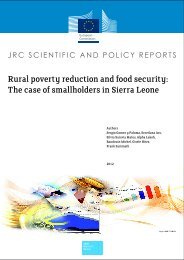(DG JRC/IPTS) - agrilife - Europa
(DG JRC/IPTS) - agrilife - Europa
(DG JRC/IPTS) - agrilife - Europa
Create successful ePaper yourself
Turn your PDF publications into a flip-book with our unique Google optimized e-Paper software.
and quality cues, to demonstrate the necessary requirements for effective<br />
communication of quality cues to customers in the supply chain and<br />
consumers at place of purchase. The "perceived quality" approach to product<br />
quality is adopted and the links between intrinsic/extrinsic cues and<br />
experience/credence attributes of a product are developed. The framework is<br />
applied to the UK meat sector by considering which attributes/cues are altered<br />
by farm assurance schemes and, hence, which type of cue is needed to signal<br />
these attributes, and what elements are necessary for effective signalling of<br />
this type of cue.<br />
Northen J.R. (2001), “Using farm assurance schemes to signal food safety to multiple<br />
food retailers in the UK”, International Food and Agribusiness Management,<br />
vol. 4, n. 1-2001, pp. 37-50. A survey of abattoirs in the UK and a logistic<br />
regression to assess significance are used to test the following hypoteses: a)<br />
buying farm assured livestock is a highly significant positive factor in selling<br />
meat to large multiple retailers; b) industry-led farm assurance schemes are<br />
indeed used by large multiple retailers as a credible signal of food safety and<br />
other “credence” attributes.<br />
Pettitt R.G. (2001), “Traceability in the food animal industry and supermarket chains”,<br />
Revue Scientifique et Technique de l’Office Internacional des Epizooties, vol.<br />
20, n. 2-2001, pp. 584-597. This article examines the introduction of<br />
traceability systems in the food animal industry and supermarket chains in the<br />
UK after the BSE crisis.<br />
Roosen J., Lusk J. and Fox J. (2003), “Consumer demand for and attitudes toward<br />
alternative beef labelling strategies in France, Germany and the UK”,<br />
Agribusiness, vol. 19, n. 1-2003, pp. 77-90. Using data from mail surveys in<br />
France, Germany and the United Kingdom, this study analyses consumer<br />
preferences for alternative beef labeling strategies: brands, origin labels, and<br />
mandatory labeling of beef from cattle fed with genetically modified feed.<br />
Simpson B., Muggoch A. and Leat P. (1998), “Quality assurance in Scotland’s beef and<br />
lamb sector”, Supply Chain Management: an International Journal, vol. 3, n. 3-<br />
1998, pp. 118-122. This paper outlines the Scotch Quality Beef and Lamb<br />
Association (SQBLA) approach to quality assurance and product traceability<br />
in the beef and lamb sectors. The schemes employed have been extended to<br />
include other sectors in the meat supply chain. The paper also outlines the<br />
operation of one of the complementary but separate schemes which are run by<br />
some processor/retailer partnerships - Scotbeef's Beeftrack system.<br />
Spriggs J., Hobbs J. and Fearne A. (2000), “Beef producer attitudes to co-ordination and<br />
quality assurance in Canada and in the UK”, International Food and<br />
Agribusiness Management Review, vol.3, n.1–2000, pp. 95-110. The purpose of<br />
this article is to determine whether there are differences in the attitudes of beef<br />
producers in Canada and the UK to issues of horizontal and vertical<br />
coordination and quality assurance, through random sample surveys (by<br />
means of a mail questionnaire) of beef producers.<br />
Van Dorp K.J. (2003), “Beef Labelling: the emergence of transparency”, Supply Chain<br />
Management: an International Journal, vol. 8, n. 1-2003, pp. 32-40. This paper<br />
describes how the emergence of beef product information became relevant<br />
against the background of BSE. The paper describes the beef sector over time,<br />
through two case studies. From both studies, the emergence of product<br />
21

















